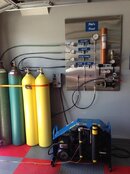Those area your shop regulations. They do not pertain to all other places in the world.
My tanks are O2 cleaned, and I myself, as a certified tank inspector, have slapped an O2 clean sticker with my inspector number on it each year. It does not have an ANDI reg number on it--it has my PSI number on it. It has never been turned down for filling anywhere I have taken it. It sounds like your shop is looking for a little extra cash.
Actually,
The DOT does not recognize the sticker of any training agency. If you want to inspect cylinders, you need approval from the DOT. Eddy current is only needed on 6351 T6 aluminum alloy at the time of requalification per 49CFR 180.209. Anyone re-qualifying, re-conditioning, repairing, etc a cylinder needs DOT approval in the USA. Annual visual inspections are not needed to satisfy DOT requirements but they are GOOD practice. They are the recommendations of CGA Pamphlet P9 and are adopted by the recreational dive industry, but they are not LAW and required by the DOT. If you are removing contaminants and certifying that the cylinder is good for O2 use, you should have approval as it is considered reconditioning. If you rebuild valves and change o-rings, etc on the pressure vessel, it is considered a repair and you should have approval.
Furthermore, if you want to learn how to clean a cylinder properly, I suggest getting instruction from a certified approved DOT facility or getting training at Wendell Hull and Associates in New Mexico, USA. I was recommended to them by NAVSEA as it is who the US Navy uses. They are also recognized for training by the DOT. Bear in mind that upon completion of training, one needs to apply to the DOT for approval to inspect and recertify cylinders. It is similar to going to Captain's School for training as a Captain in the USA. You get a diploma from Captain's School upon completion of their course, but you are not approved by the Coast Guard as a Captain until you meet all of the application and testing requirements and are issued your Merchant Mariner Credential. The certificate you get from any training agency is not recognized as approval by the DOT. It only certifies that you received training from someone, however, this does not certify approval requirements.
Here is the link to Wendell Hull:
Forensic Engineering & Oxygen Safety Experts - Wendell Hull & Associates, Inc.
It is a lot of information, I know, but trust me, once you start to get the real picture, you will be surprised. At least here in the USA!!!!
---------- Post added May 19th, 2013 at 04:59 PM ----------
Sorry,
It is actually CGA P-5 not P-9 that is the Suggestions for the Care of High Pressure Air Cylinders for Underwater Breathing. My mistake!!





